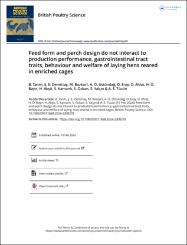Feed form and perch design do not interact to production performance, gastrointestinal tract traits, behaviour and welfare of laying hens reared in enriched cages

View/
Access
info:eu-repo/semantics/openAccessDate
2024Author
Tarım, B.Demirtaş, Ş. E.
Bozkurt, M.
Üstündağ, A.Ö.
Eray, O.
Ahlat, O.
Bayır, H.Ö.
Akşit, H.
Kamanlı, S.
Özkan, S.
Yalçın, S.
Tüzün, AE
Metadata
Show full item recordCitation
Tarım, B., Demirtaş, Ş. E., Bozkurt, M., Üstündağ, A. Ö., Eray, O., Ahlat, O., ... & Tüzün, A. E. (2024). Feed form and perch design do not interact to production performance, gastrointestinal tract traits, behaviour and welfare of laying hens reared in enriched cages. British Poultry Science, 1-14.Abstract
1. It was hypothesised that perch material and design may affect utility and maintenance energy demand in laying hens, affecting their feed form preferences and daily feed consumption. Accordingly, perch design and feed form on hen performance, gastrointestinal tract functions and some behavioural and welfare-related traits were studied in laying hens (ATAK-S) reared in enriched colony cages from 24 to 40 weeks of age. 2. The experiment was a 2 × 2 factorial investigating two perch materials and design (circular steel or mushroom-shaped plastic) and feed form (mash or crumble). A total of 396 hens were randomly assigned to one of the four treatment groups with nine replicates each (11 birds per replicate). 3. Except for feeding behaviour and prevalence of foot pad dermatitis at 40 weeks of age, the modification of the perch design did not have a significant effect on the traits examined. Mushroom-shaped plastic perches reduced feeding behaviour (p < 0.01) and the incidence of foot pad dermatitis at 40 weeks of age (p < 0.001). 4. Performance traits were not affected by feed form. Intake, final body weight and FCR for crumble-fed laying hens were greater than those fed mash (p < 0.01). 5. Hens fed mash had higher (p < 0.01) relative gizzard weights along with lower (p < 0.05) pH values, pancreatic chymotrypsin, amylase and lipase activities (p < 0.05), and duodenal absorption surface areas (p < 0.01). Ultimately, this gave higher protein digestibility (p < 0.05) compared to those receiving crumble. 6. In conclusion, in enriched cage rearing systems, mashed feed was preferred over crumble to efficiently maintain productive performance. Compared to circular steel, plastic mushroom-shaped perches were associated with better footpad health and welfare. © 2024 British Poultry Science Ltd.

















